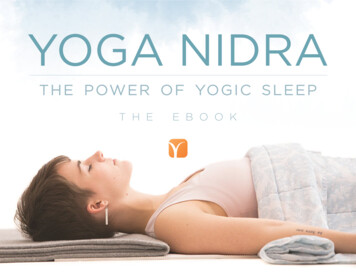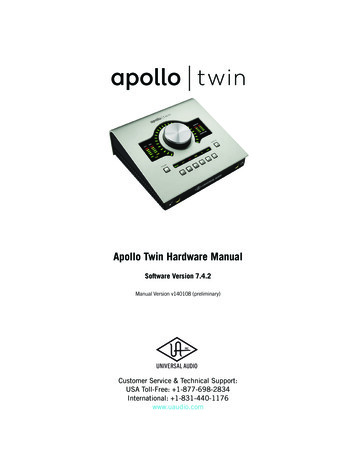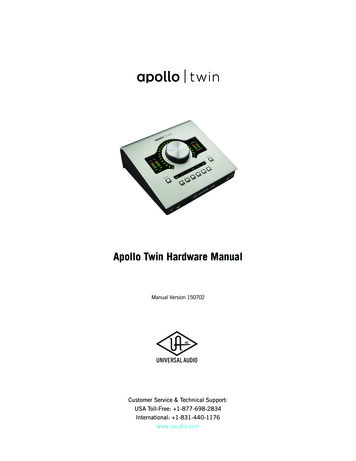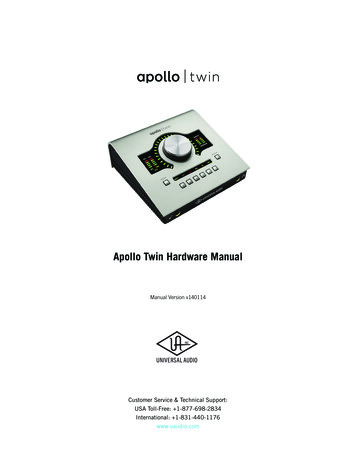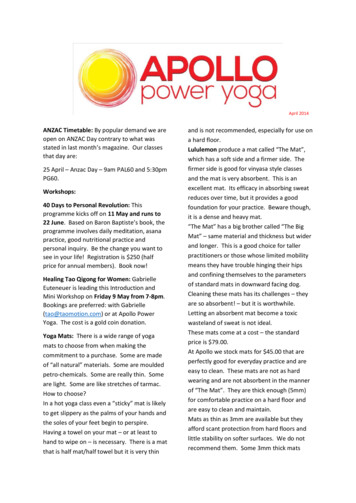
Transcription
April 2014ANZAC Timetable: By popular demand we areopen on ANZAC Day contrary to what wasstated in last month’s magazine. Our classesthat day are:25 April – Anzac Day – 9am PAL60 and 5:30pmPG60.Workshops:40 Days to Personal Revolution: Thisprogramme kicks off on 11 May and runs to22 June. Based on Baron Baptiste’s book, theprogramme involves daily meditation, asanapractice, good nutritional practice andpersonal inquiry. Be the change you want tosee in your life! Registration is 250 (halfprice for annual members). Book now!Healing Tao Qigong for Women: GabrielleEuteneuer is leading this Introduction andMini Workshop on Friday 9 May from 7-8pm.Bookings are preferred: with Gabrielle(tao@taomotion.com) or at Apollo PowerYoga. The cost is a gold coin donation.Yoga Mats: There is a wide range of yogamats to choose from when making thecommitment to a purchase. Some are madeof “all natural” materials. Some are mouldedpetro-chemicals. Some are really thin. Someare light. Some are like stretches of tarmac.How to choose?In a hot yoga class even a “sticky” mat is likelyto get slippery as the palms of your hands andthe soles of your feet begin to perspire.Having a towel on your mat – or at least tohand to wipe on – is necessary. There is a matthat is half mat/half towel but it is very thinand is not recommended, especially for use ona hard floor.Lululemon produce a mat called “The Mat”,which has a soft side and a firmer side. Thefirmer side is good for vinyasa style classesand the mat is very absorbent. This is anexcellent mat. Its efficacy in absorbing sweatreduces over time, but it provides a goodfoundation for your practice. Beware though,it is a dense and heavy mat.“The Mat” has a big brother called “The BigMat” – same material and thickness but widerand longer. This is a good choice for tallerpractitioners or those whose limited mobilitymeans they have trouble hinging their hipsand confining themselves to the parametersof standard mats in downward facing dog.Cleaning these mats has its challenges – theyare so absorbent! – but it is worthwhile.Letting an absorbent mat become a toxicwasteland of sweat is not ideal.These mats come at a cost – the standardprice is 79.00.At Apollo we stock mats for 45.00 that areperfectly good for everyday practice and areeasy to clean. These mats are not as hardwearing and are not absorbent in the mannerof “The Mat”. They are thick enough (5mm)for comfortable practice on a hard floor andare easy to clean and maintain.Mats as thin as 3mm are available but theyafford scant protection from hard floors andlittle stability on softer surfaces. We do notrecommend them. Some 3mm thick mats
start to stretch under the strain of downwardfacing dog. Such mats are unsuitable. Eventhe 3mm thick Jade and Manduka mats (madefrom a lovely fabric with a good grippingtexture to practice on) will not please thepoints of your hips as you take floor bow oryour knees in dragon. Jade and Manduka(eKO mat) both produce mats that aresustainably produced using natural rubber.Manduka have been making a mat called “TheBlack Mat” for years. It is thicker, very hardwearing and well-reviewed. This mat willimprove in feel once it has been used a littleand some of its freshly manufactured sheen isgone. At US 100 it is not cheap but willoutlast most other mats available and there isa long-term saving in that. It is not strictly aneco-mat but if it does not need to be replacedas regularly as other mats it helps theenvironment in that way.prAna is another mat producer of goodrepute. I have used their E.C.O. mat. It wasgood while it lasted but it did not last long andwas a bit slippery. Since I purchased mine,they claim to have made improvements to thismat. I also had an extra-large prAna mat that Icalled “the road” because it just rolled out flatlike a road. It too was good while it lasted. Istill use it at home from time to time but itwore heavily where I put my hands and feetand The Black Mat by Manduka would bepreferable.There are plenty of good mats out there.There are also some absolute stinkers. DoNOT buy a cheap mat from the Warehouse.They have been selling things that are too thinand too short to practice on. Know thedimensions before you buy. A yoga mat needsto be at least 6 feet (72 inches/180cm) long.They also need to be wide enough. I recentlysaw a man trying to do downward facing dogon a mat so narrow he has his hands on thefloor either side of the mat. A mat needs tobe at least 2 feet wide (24 inches/60cm).Many men will need a longer and wider matthan that.Mats do not last forever. If your mat is leavinglittle pieces everywhere it is time for you toget a new one. If the mat is coming apart it isceasing to provide you with the stability andsupport you need.Rental mats. When renting a mat pleaseensure your toenails are not too long. Theycause excessive wear if they are long and cutinto the mat. Clean your rental mat after usewith the spray bottles and sponges providedand leave it lying flat in the practice room toair dry. If you are particularly sweaty pleaseclean both sides of the mat and move it offthe place where you practiced. Thank you.A final word on mat etiquette. Try not tostand on other people’s mats unless it isnecessary, for example, when assisting themin a workshop.New Hemisphere Hempseed Oil Draw: NewHemisphere have been kind enough to donatethree bottles of their New Zealand madehempseed oil to us. The winners are the threepeople who practiced the most at ApolloPower Yoga from 20 March to 18 April.The winners are: Alice Matheson, OwenPaulsen and Janet Jones-Poole.Please collect your bottle of New Hemispherehempseed oil when you are next at the studio.For more information about hempseed oilplease visit this website:http://www.nzhempoil.co.nzBaptiste Yoga Teacher Training – Journey intoPower: Have you been thinking about trainingto be a yoga teacher, either in addition to yourcurrent work or as a career change? Or wouldyou just like to immerse yourself in asana,
meditation and personal inquiry for a week?Either way, you should consider the Journeyinto Power programme at the Baptiste PowerYoga Institute (BPYI).Go to the SourceThe style of yoga that we practice at ApolloPower Yoga was created by Baron Baptisteduring the 1980s. Since then, many otheryoga teachers have adopted the style, and insome cases modified it – often by watering itdown to make it a weaker practice. When youundertake your teacher training with Baron,you are going to the source. Baron is theperson who created this style of yoga, and onhis trainings, Baron himself conducts most andsometimes all of the asana and other trainingsessions. It is an amazing opportunity to bringyour own practice up to a higher level, whilelearning how to teach yoga from a true masterfacilitator.What is the First Step?BPYI has structured its teacher trainingprogramme to make it accessible, even forthose who have to travel from a distance. Thefull training course is broken down intocomponents, so that completion of the firstcomponent (Level 1) enables you to startteaching. Going deeper into your training bytaking Levels 2 and 3, and becoming a certifiedteacher, is your option. But getting Level 1under your belt is all you need to get into theyoga room, teaching classes with skill andauthenticity.And even if you’re not considering teaching,Level 1 is still a great programme to take.Unlike yoga “retreats” where you simplypractice asana, Journey into Power includesmeditation and personal inquiry, to lead youinto a more yogic way of being.What to ExpectJourney into Power (Level 1) runs for 8 days.They are very full days, commencing with aguided meditation, and then an asana practicefor about 3 hours. The mediation and asanapractice are led by Baron. Being taught byBaron for this amount of time brings your ownpractice up to a higher level, and provides youwith key understandings of how to effectivelyteach a yoga class.These understandings are added to during themiddle part of the day, when there arepersonal inquiry sessions conducted by Baronand other facilitators. The approach taken isthat no one else can teach you how to teach,because just repeating what another teachersays will not enable you to teach withauthenticity. The BPYI training enables you tofind the teacher in you, and let that teachershine forth. This usually means letting go oflimiting beliefs you have developed, and thatprocess occurs most effectively throughpersonal inquiry.Letting your inner teacher shine forth is putinto practice later in the day (and often farinto the evenings) when the larger groupseparates into small groups of 5, and eachperson takes turns teaching the other 4. Thismeans that you spend most of this time beingtaken through more asana practice (just incase the 3 hour practice in the morning wasn’tenough for you). All of the small groups arelocated in the one large practice room, so thismeans that you have to find the confidence,concentration and volume to make yourselfheard to your group, while every other groupis doing the same thing. After doing that for 8days, teaching in a regular classroom is a pieceof cake!Where and when is Journey into Power?BPYI runs 2 or 3 Journey into Powerprogrammes every year, in different locations.Most of the locations are on mainland USA,but every few years a programme is run inHawaii. The locations are usually “retreat”type settings, in parks or nature reserves.Accommodation ranges from individual orshared units to camping options.
For 2014, there are currently two Journey intoPower programmes being offered: Sedona(Arizona) in June, and the Catskills (New YorkState) in August. You can check out furtherdetails on the Baptiste websitewww.baronbaptiste.com. Asana Spotlight: Reverse Warrior is a dynamicpose involving a deep lunge, lengthening andstrengthening the muscles of the legs, hipopening and back bending. Draw the powerup from the earth and radiate outwardsthrough your heart. From Warrior 2 with your right footforward turn your right palm up to theceiling with an external rotation of theright arm.Simultaneously begin to raise your rightarm straight up to the sky as you loweryour left hand down behind you to yourleft thigh. Stretch from the top of theright hip, through the waist, the rib cageand the armpit all the way up to yourwidespread fingers at your right hand.Often students begin to lift up out of thelunge at the right knee as they raise theirright arm to the sky. Resist this and staydeep in the lunge.The left hand can rest lightly at your leftthigh or can wrap behind your back. Ifyou wrap the arm behind you work towards slipping your left fingers to theinside of your upper right thigh with yourleft shoulder blade drawn in towards yourspine. If resting your left hand at youthigh do not collapse your weight into theleft hand.When you have reached as high throughyour right arm as you are able you maybegin to extend your spine and reach yourupper arm over your head towards thewall behind you, arching your spinebackwards.Your back leg is a bandha here. Do notallow any collapse of the back leg. Hugthe outer edge of the left foot to the floorand lift through the inner left thigh andpelvic floor. This will give you a powerfullaunch pad from which to free up yourspine.To make the most of this backbend, drawyour right shoulder blade down your backand lift your thoracic spine up into yourchest.Set your gaze through your upper handand turn your awareness inward to thepower of the pose in your body.You may find your breathing becomesrestricted. Stay calm and breath evenlybut perhaps not trying to completely
empty and then fill your lungs with eachbreath. Try using half to three-quarters ofyour lung capacity.Hold here for five breaths. Then inhaleand cartwheel your two hands down tothe mat and step back into chaturangadandasana before flowing to downwardfacing dog and taking the opposite footforward to repeat Warrior 1, Warrior 2and Reverse Warrior.Open your heart and throat and shine fromyour inner beauty.Chakra Theory: In our ascent through thechakras we have reached the heart chakra,Anahata. The focus in this chakra is love. Thecentremost of the chakras concerns abalancing of all the others and uniting them inour way of being. We have moved from themore physically oriented chakras to a morespiritually oriented one.The love of this chakra is to be distinguishedfrom that of the second chakra, Svadhisthana.The second chakra concerns desire andphysical love which is centred on anotherperson. The love of Anahata is a divinepresence of empathetic connection. This lovehas an eternal quality to it and thus also has astill, unchanging character.The name Anahata has an interesting meaningin Sanskrit: the sound made without any twothings coming together. That definition issometimes extended to meaning unhurt oreven clean and pure. In essence this isacceptance of our condition – not approachingour self-image from any sense of lack but froma viewpoint of love.The heart chakra is a yin chakra. The thirdchakra, heating and motive in its nature is veryyang in quality. The heart is yin. There ismore here to be gained by relaxing with whatis, being rather than doing, allowing ratherthan creating or forcing.The forces at work here are not intellectual interms of thinking and mind analysis. They areintuitive based on feeling. When the mindgets in the way we can lose the power of theheart. A fear of rejection can prevent usopening up to another. The mind restricts theflow of energy through the heart chakra.What we put out we get back. As we put outaloofness and disconnected individualityothers will see as unwelcoming, lackingempathy and warmth and will mirror thatback to us.Opening our hearts can feel vulnerable but isultimately rewarding. The love we put out willbe felt by others and we will receive it back.The heart chakra is located at the centre ofthe chest but extends to the physical organs ofthe heart and lungs and out through the armsto the hands. As da Vinci’s Vitruvian Manshows, the vertical line of the sushumnathrough the spine is intersected by ahorizontal line through the extended arms.The intersection point is the centre of theheart chakra but the influence of the heartchakra extends outwards through the armsand also up and down, balancing andintegrating the forces and energies of theother six chakras. The heart chakra connectswith the thymus gland.
The healing powers of love emanating fromthe heart chakra can be given effect throughthe hands. An empathetic touch, an embraceor a massage are all ways of expressinghealing from the heart’s love.As the lungs are included within this chakra,breathing is a powerful Anahata action. Prana(Sanskrit for breath) connotes life force. Ourrespiratory system is highly efficient. The foodwe eat or the fluid we ingest takes time toreach our cells but air breathed in is almostinstantaneously converted into oxygen in thered blood cells and is carried to all the cells inour body. Through our breathing patterns wecan resolve chronic tension that comes fromfear or anxiety. We can allow each exhalationto be a physical and a spiritual release.Breathe consciously and deeply and feel thefull expression of breath in your being.The tantric symbol of Anahata is a twelvepetalled lotus. Inside are two trianglesforming a six-pointed star (the same as theStar of David). The two triangles overlappingin this star represent the union of masculineand feminine and also each point canrepresent the six other chakras with the heartchakra at the centre.downward pointing triangle. Isvara, the Godof unity and Shakti Kakini (a femalecounterpart) are typically shown in the symbolas well as an antelope, which is symbolic offreedom. Green is the colour most oftenassociated with this chakra.The deities Vishnu, Lakshmi, Krishna andIsvara, all very powerful and noble, areassociated with Anahata.Pranayama in the form of nadi shodana(alternate nostril breathing), kapalabhati(breath of fire or skull-cleansing breath) andcomplete breath (in which one inhales intothe abdomen, then the chest and then theshoulders and throat followed by anexhalation in reverse order down the body)are all Anahata exercises as they stimulateand encourage the breath. The three principalbandhas (jalandhara, uddiyana and mula) aresaid to trap air in the corresponding parts ofthe body and are, accordingly, Anahata breathexercises.Yoga poses that open the heart chakra arefish, cobra and a chest opening forward fold inwhich the hands are clasped behind the backand as you bow forward the arms move overyour head towards the floor. In this action theshoulder blades are drawn in towards oneanother promoting the thoracic spine intowards the centre of the chest and the chestis spread wide.Arm circles where the arms are liftedoutwards to shoulder height and circles ofever increasing diameter are made , first inone direction and then in the oppositedirection, and twists of the torso with thearms extended outwards at shoulder heightare also heart opening physical exercises.Meditations for Anahata can include:In the centre of the symbol is a Shiva Lingum(a symbol of the Lord Shiva) within a1. An empathy exercise in which you placeyourself in the position of someone withwhom you are having difficulties and
consider your mutual situation from theirpoint of view.2. A compassion meditation in which you sitalone visualising others or sit togetherwith another or others or sit in a publicplace. Imagine all that is in the hearts ofothers– fears, doubts, grief, challenges oflife. Fill your heart with love andcompassion and send that love in thoughtto them. Do not try to hang on to theconnection. Give them love them move tosomeone else.3. Appreciation ritual. Gather with anotheror others in a comfortable space withoutdistractions. In turn call one person toreceive appreciation from the others – nocriticism, no advice. Just appreciationfrom sincerity. For example, “I like theway you make time every day to ask yourchildren about their day”.4. Wishing Tree. It is said that lying justbelow the heart is the Kalpataru, orwishing tree lotus that holds the deepestwishes of the heart. Lie still, connect withyour breath. Disconnect from thoughtand feel the intuitive knowledge at yourheart. What does your heart desire? Askfor it.NamasteHamish and Margo Hamish Kenworthy and Margo Perpick 2014
Apr 01, 2019 · Either way, you should consider the Journey into Power programme at the Baptiste Power Yoga Institute (BPYI). Go to the Source The style of yoga that we practice at Apollo Power Yoga was created by Baron Baptiste during the 1980s. Since then, many other yoga teachers have adopted the st

